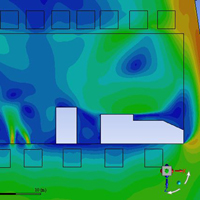Improving natural ventilation in renovated free-stall barns for dairy cows: Optimized building solutions by using a validated computational fluid dynamics model

Published: 18 March 2021
Abstract Views: 2483
PDF: 840
HTML: 276
HTML: 276
Publisher's note
All claims expressed in this article are solely those of the authors and do not necessarily represent those of their affiliated organizations, or those of the publisher, the editors and the reviewers. Any product that may be evaluated in this article or claim that may be made by its manufacturer is not guaranteed or endorsed by the publisher.
All claims expressed in this article are solely those of the authors and do not necessarily represent those of their affiliated organizations, or those of the publisher, the editors and the reviewers. Any product that may be evaluated in this article or claim that may be made by its manufacturer is not guaranteed or endorsed by the publisher.
Similar Articles
- Angelo Fabbri, Chiara Cevoli, Giuseppe Cantalupo, A method for handlebars ballast calculation in order to reduce vibrations transmissibility in walk behind tractors , Journal of Agricultural Engineering: Vol. 48 No. 2 (2017)
- Alvaro Marucci, Danilo Monarca, Massimo Cecchini, Andrea Colantoni, Andrea Cappuccini, Analysis of internal shading degree to a prototype of dynamics photovoltaic greenhouse through simulation software , Journal of Agricultural Engineering: Vol. 46 No. 4 (2015)
- Mauro Podrecca, Alessandro Chiumenti, Francesco Da Borso, Marco Contin, Maria De Nobili, Reduction of odorous compounds emissions from swine slurry by electrolytic treatments and copper addition , Journal of Agricultural Engineering: Vol. 48 No. 1 (2017)
- Giacomo Scarascia-Mugnozza, Silvana Fuina, Sergio Castellano, Structural design and experimental tests on a model of tensegrity greenhouse prototype , Journal of Agricultural Engineering: Vol. 52 No. 3 (2021)
- Giorgia Cocolo, Silvia Curnis, Maibritt Hjorth, Giorgio Provolo, Effect of different technologies and animal manures on solid-liquid separation efficiencies , Journal of Agricultural Engineering: Vol. 43 No. 2 (2012)
- Timothy Denen Akpenpuun, Qazeem Opeyemi Ogunlowo, Wook-Ho Na, Prabhat Dutta, Anis Rabiu, Misbaudeen Aderemi Adesanya, Mohammadreza Nariman, Ezatullah Zakir, Hyeon Tae Kim, Hyun-Woo Lee, Dynamic neural network modeling of thermal environments of two adjacent single-span greenhouses with different thermal curtain positions , Journal of Agricultural Engineering: Vol. 55 No. 2 (2024)
- Melis Inalpulat, Monitoring and multi-scenario simulation of agricultural land changes using Landsat imageries and future land use simulation model on coastal of Alanya , Journal of Agricultural Engineering: Vol. 55 No. 1 (2024)
- Francesco M. Tangorra, Aldo Calcante, Stefano Nava, Gabriele Marchesi, Massimo Lazzari, Design and testing of a GPS/GSM collar prototype to combat cattle rustling , Journal of Agricultural Engineering: Vol. 44 No. 2 (2013)
- Andrea Petroselli, Dario Romerio, Piero Santelli, Roberto Mariotti, Silvano Di Giacinti, Luca Casini, Carmine Testa, Assessing sprinkler systems performance with a novel experimental benchmark , Journal of Agricultural Engineering: Vol. 52 No. 3 (2021)
- Monica Parlato, Simona M.C. Porto, Giovanni Cascone, Raw earth-based building materials: An investigation on mechanical properties of Floridia soil-based adobes , Journal of Agricultural Engineering: Vol. 52 No. 2 (2021)
<< < 4 5 6 7 8 9 10 11 12 13 > >>
You may also start an advanced similarity search for this article.

 https://doi.org/10.4081/jae.2021.1135
https://doi.org/10.4081/jae.2021.1135






